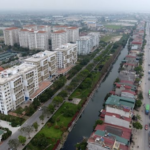“Social Housing Dreams: Strategies for Effective Development”
During the seminar “Realizing the dream of social housing,” Mr. Le Van Binh, Deputy Director of the Land Administration Department, Ministry of Natural Resources and Environment, shared that developing social housing projects is currently a top priority.
Social housing is exempt from land use fees, so the primary concern is contractor selection and bidding processes. Allowing investors to implement social housing projects without bidding is a novel approach to promote social housing development, with a target of completing one million units by 2030.
A crucial consideration is how local governments plan for social housing. It should not be built in isolated or inconvenient locations but rather cater to the needs of residents regarding transportation and amenities. Ideally, social housing should be centrally located with easy access to transportation for low-income earners and eligible workers.

Mr. Le Van Binh, Deputy Director of the Land Administration Department, Ministry of Natural Resources and Environment.
Mr. Binh suggested utilizing surplus office spaces from provincial mergers for social housing development. With the upcoming two-tier government structure, these surplus spaces could be prioritized for social housing projects. In larger provinces, these projects can be located in outer areas but should not be too remote.
Local governments should carefully consider and allocate land for social housing to meet demand. Poor planning may result in completed projects that remain unsold. Some areas experience high demand, while others struggle to sell units for years. Proper planning and central location are key to ensuring demand and successful sales.
Additionally, while local governments allocate land, enterprises should also conduct thorough site surveys, considering land prices and understanding the needs of residents in the project area and its vicinity. This will help grasp the customer base and their requirements.
Depending on the available land, there should be flexibility in constructing apartment buildings or individual homes. Diversifying housing types and developing various social housing options for rent can cater to a wider range of beneficiaries. This approach will help maintain a long-term housing fund to serve the needs of residents regarding housing and employment.
“The Case for Holistic Leadership: Vice Premier Ho Duc Phoc on Why Leadership Excellence Extends Beyond Provincial Wealth”
“The notion of ‘I spend what I earn’ is shortsighted. Who will tend to our border provinces and care for those in less fortunate regions? These are the concerns voiced by Deputy Prime Minister Ho Duc Phoc during his conversation with reporters at the National Assembly on May 26th.”
Unlocking the Challenges of Social Housing Development: A Government-Led Imperative.
To address the challenges in social housing development, the Vietnam Real Estate Brokers Association (VREBA) advocates for a paradigm shift in management and governance. They propose that developing social housing should be regarded as a mandatory component of each locality’s socio-economic development strategy, with the state taking a leading role rather than leaving it to market forces.
The Bureaucratic Stranglehold: How Red Tape is Stifling Vietnamese Businesses at Home
“A significant number of private enterprises in Ho Chi Minh City are facing obstacles to their growth due to bureaucratic red tape, high financial costs, and an uneven playing field in the business environment. These challenges are preventing them from reaching their full potential and hindering their ability to scale up their operations.”





















